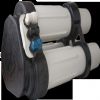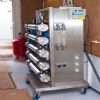Reverse osmosis
For some complex chemistries and where very pure water is required reverse osmosis (RO) is an effective treatment option. This can range from commercial units to small single tap treatment units and can remove a number of things including chlorine, aluminium, nitrates, chlorides and sodium.
Large scale and commercial reverse osmosis systems are able to re-process some of the waste-water making them more efficient, however all RO systems will create waste water and therefore the yield must be sufficient to support this. For more information regarding large or commercial units please contact the office.
Small domestic under-sink units can be installed easily with a designated drinking faucet providing a single treated supply at a relatively low cost.
Domestic RO systems will remove approximately 95% of the contaminants such as chlorine, nitrates, lead, fluorides, bacteria, viruses and unpleasant tastes and odours.
RO systems, in their basic form, consist of a pressure pump, housing and the membrane. Water is forced into the housing and the pure water is collected and used for service.
In most instances the full chemistry of the water needs to be understood in order to protect the membranes, we need to consider the following:
-
Particles > 5micron
-
Cl (chlorine) > 0.1ppm
-
Fe (iron) >0.05ppm
-
Mn (manganese) >0.05ppm
- Temperature >45ºC
- Pressure - we need to be careful of the back pressure on the product water line during design phase
It is also recommended that the following parameters are considered as they can also reduce the life the membrane.
- Calcium hardness as CO3
- Silicates
- Organics
- Biological contamination
| Further information is available | |||||
|
|
||||
| Related images in this section Click for a larger image and description |
|
|








